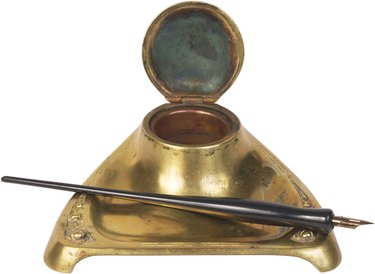Things You'll Need
5 grams of gallnuts
1 gram of ferrous sulfate
1 gram of gum Arabic
200 grams of water
1 gram carbolic acid
Mortar and pestle
Ink jars
Mason jar
Coffee filter
Spoon with holes

Making ink is a fine art from the ancient days. While writing with quill pens has for the most part gone out of the current fashion, it is still used in recreational hobbies and crafts. Ink is also popular for putting in certain types of pens for calligraphy purposes. Making ink is not all that difficult but it does take some time. Ink can severely damage any porous surface it comes into contact with, so be careful when making your ink. You can purchase these ink ingredients in educational science--specifically chemistry--and extreme craft stores.
Step 1
Grind the gallnuts to a fine powder in the mortar and pestle.
Video of the Day
Step 2
Immerse the gallnut powder in 100 grams of water.
Step 3
Let the mixture sit for a few weeks. Mold will cover the surface of the liquid.
Step 4
Skim off the mold with the spoon.
Step 5
Pour the remaining liquid through a coffee filter into a clean jar.
Step 6
Dissolve the ferrous sulfate and the gum in the remaining water.
Step 7
Add to the liquid along with the carbolic acid to keep the mixture from molding.
Step 8
Pour into ink jars and seal.
Tip
You can use distilled or tap water, and you can also double the recipe as desired.
You can buy these ingredients online or at most chemistry stores.
The resulting color of the ink should be black. Unfortunately this recipe will not make different colored inks.
Warning
Some of these ingredients may be combustible. Use caution and do not use any fire around these substances.
Some of these chemicals are caustic and will cause harm if you come into close contact with them without any protection. When handling and mixing chemicals always use protective gear such as safety goggles, rubber gloves, and a coat or apron to cover your clothes.
Video of the Day